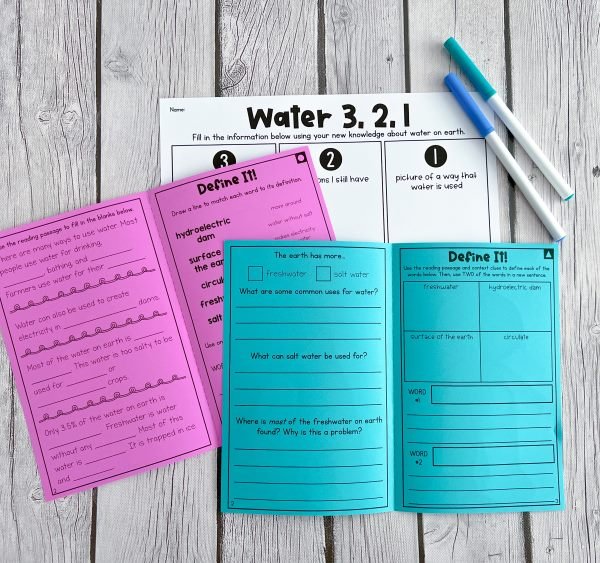Water on Earth Activities for Kids
We drink water, cook with water, bathe in water, swim in water, clean with water, etc. I’d say water is pretty important and definitely integral to our lives. Come and explore the wonderful world of water with your students by learning about why water is important on Earth and how much water on the Earth is usable. Plus, check out some water activities you can do at home or in the classroom!
How much water is on Earth?
Most of the Earth is covered in water. In fact, 71% of the Earth’s surface is covered by water. But only 3.5% of that water is freshwater and most of this water is frozen!
Why is water important to Earth?
People use water for many reasons, including cleaning, cooking, drinking, and bathing. Water is also essential for growing crops. Many places use water to heat and cool buildings, and it can be used to generate electricity. Plus, drinking water is important for our health. Water is very important!
The EASY Way to Teach Water and the Water Cycle
Learn all about water on earth with this hands-on unit that has everything you need.
Scripted lessons… check!
Vocabulary … check !
Reading passages… check!
Hands-on projects … check!
Engaging? Double check!
Reading about Water on Earth
When students are learning a new science topic, it’s helpful to have students read about it. Plus, it integrates reading right into our science lesson! These Water on Earth’ reading passages and comprehension booklets are perfect for this. They’re in two levels so you can differentiate them for your class.
With the passages, students will learn about why water is important. They will also be learning where water is found and the different types of water (ie. freshwater and saltwater). Grab them here!
Group Activity - exploring Sources of Water
Group projects are a great way to have students engage with a topic and also practice skills like teamwork, conversation, problem-solving, and task management.
This Sources of Water group activity is perfect for all of this! Assign each group a water source to research. Each group will become the ‘expert’ on their own source of water, and teach the rest of the class about it. Eventually, the whole class will have compiled a booklet of information about all of the water sources!
The activity can be found in my Water Cycle science unit!
Project: Conserving Water
To teach about water conservation, a guided inquiry project is a great option! This flipbook (included in the Water Cycle unit) will have students answering the question “How can we conserve water?” Students can pick their own focus and then do some basic research.
While doing this project, students will look for information about why conserving water is important and they will hunt for solutions to the problems they discover. They will present their information in the flipbook.
Alternatively, students could present their findings in another way: website, a model, a book, a TED talk, etc.
This project (teaching guide, flipbook template, assessment) is a part of the complete Water Cycle Unit.
water cycle bag activity
The Water Cycle Ziploc Bag is an old favorite for many. This water activity is a great way to have students observe the water cycle in action. Simply draw the water cycle on a ziplock back, add some water, seal the bag, and tape the ziplock to a window. After a few days, you’ll be able to see the water in action: evaporation and condensation. Take a detailed look at the activity right on the Ziploc website!
become a water detective
Have children brainstorm ways they can conserve water. Here are a few quick and practical things they might come up with:
Turn the tap off while brushing their teeth
Put a water saver in the toilet tank
Limit time in showers
Instead of dumping undrunk water down the sink, use it to water plants
Rewear clothes if they aren’t dirty so the washing machine doesn't have to be run as many times
Become drip detectives. Did you know that a leaky toilet can waste 200 gallons of water per day? And a dripping faucet can waste over 5 gallons of water per day! So teach children to become leak detectives so the problem can be fixed right away!
Water is everywhere! We use water every day and often it goes underappreciated. Children can learn a lot about water when a few fun and engaging water activities are implemented.
Featured by Twinkl in World Water Day 2025 Resources.








